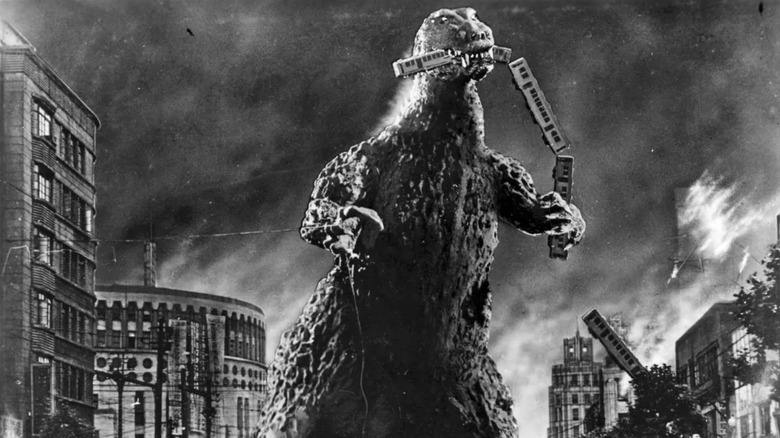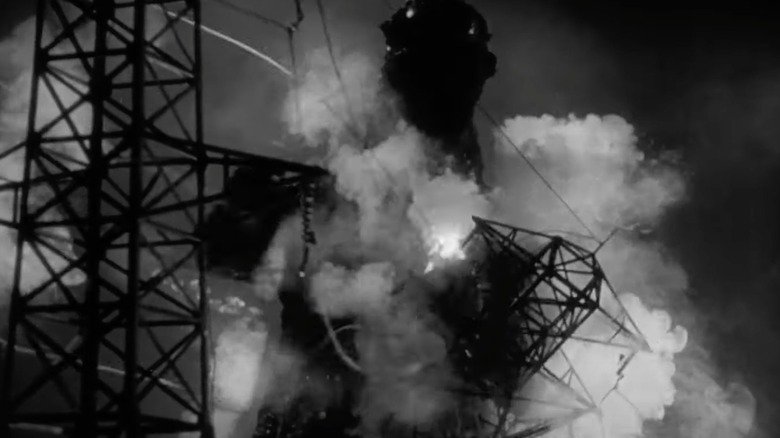The Special Effects Wizards Behind Godzilla Were Accused Of Being Terrorists
The original 1954 "Godzilla" was directed by Ishirō Honda, butithout minimizing his importance, it's impossible that the film would have turned out the same way without the special effects Director Eiji Tsuburaya. Portraying a giant monster with the convincing scale of Godzilla had almost never been done before (see the preceding year's monster flick "The Beast From 20,000 Fathoms") and crafting the monster was Tsuburaya's responsibility.
Tsuburaya had a prolific career that began almost 30 years before he worked on "Godzilla," and included previous collaborations with Honda on the war films "Eagle of the Pacific" and "Farewell Rabaul." Today, though, he is mostly remembered as "the father of Tokusatsu" or effects-heavy Japanese film/TV. Such productions typically depict actors in costume as giant monsters, robots, or superheroes (think "Kamen Rider", "Super Sentai," etc.). Tsuburaya earned this title not just through his work on "Godzilla" and subsequent films (such as "Rodan"), but by creating the 1967 TV series turned media phenomenon "Ultraman."
While Ultraman is a hero, Godzilla is (at least in the original) a destructive force of nature. That power is demonstrated by his ravaging of Tokyo, whose buildings pale in comparison to his monstrous size. In reality, though, this was just actors in costumes (Haruo Nakajima and Katsumi Tezuka, specifically) stomping on a miniature recreation of the metropolis.
As documented in the 2017 behind-the-scenes book "Godzilla on My Mind: Fifty Years of the King of Monsters" by William M. Tsutsui, an eavesdropper mistook Tsuburaya to have destructive intentions of his own.
Godzilla-sized destruction
Tsutsui's book describes Tsuburaya as "meticulous" in recreating Tokyo at 1/25th scale. Model houses were detailed for realism inside and out. The day before filming the sequence, he and his assistants gathered in Ginza (a Tokyo shopping district) on the roof garden of a department store. With a view of the city's skyline, they drew a line of Godzilla's rampage. Unfortunately, a security guard overheard this discussion about "destroying Tokyo" and thought the crew were terrorists. So, none the wiser, he did his civic duty and reported them to the authorities, and Tsuburaya found himself being detained by the police.
Kaiju ("strange beast") films, about giant monsters ravaging cities and/or fighting each other, are a popular subset of Tokusatsu. But these films, now a staple of Japanese cinema, began with "Godzilla." Since such films weren't in the public consciousness when "Godzilla" was being made, the guard would have no inkling that such a film could be what the crew was discussing.
Tsuburaya's detention didn't last long, thankfully, and he got to finish smashing up Tokyo (the model version, that is). In the film, the sequence plays out like this: Godzilla rises from the sea and marches toward transmission towers. Before making his way to the city, he tears some of these towers down and melts some with his atomic breath. In reality, these towers were made from wax and were melted with heat lamps. Some wide shots are level with the houses, showing them in their entirety. And yet, the frame doesn't reach higher than Godzilla's feet, conveying the scene's scale.
It may not have been worth risking prison over, but Godzilla's rampage is some impressive effects-centered filmmaking — especially for its time — and is the blueprint that later films (such as last year's hit "Godzilla Minus One") have built off of. Without Eiji Tsuburaya, there'd be no Godzilla.

